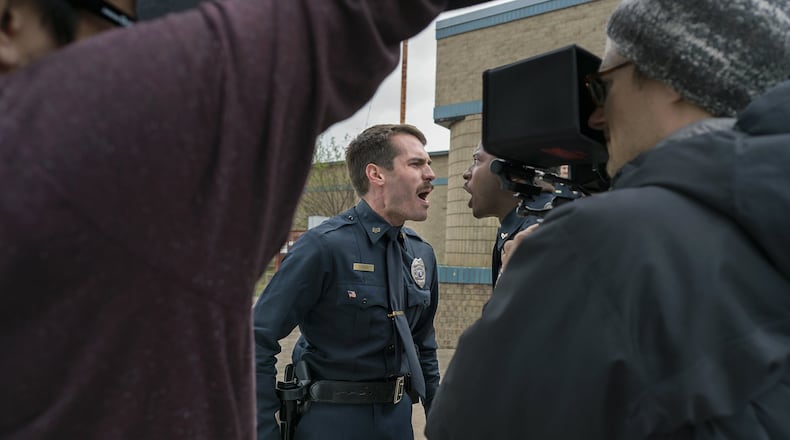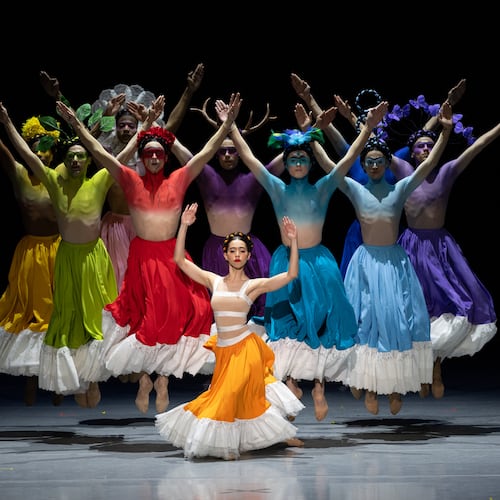Two women holding shotguns lean toward one another in an intimate embrace.
A pair of cops — one black, one white — exchange screams.
The drama is right on the surface in these photographs by Alex Harris, currently on exhibit at the High Museum of Art, but the stories are deceptive. Clues, some of them overt, tell the viewer that these moments are staged scenes, created to tell a moviemaker’s tale.
Harris, 70, an Atlanta native and co-founder of Duke University’s Center for Documentary Studies, spent several years on the sets of independent films being shot in Georgia, Louisiana, North Carolina and elsewhere in the South. His surreal images, presented in the show “Our Strange New Land: Photographs by Alex Harris,” illustrate life on the set — but also tell something more.
“I was interested in imagination,” said Harris last week. “How does the current generation imagine the South? Even if the film is not about the South or set in the South, by definition, where they choose to photograph, how they create their sets, all of that is a kind of imagined world they’ve created. It’s related to our own, but it’s not quite the same thing.”
Harris' photographic journey was supported by the High Museum as part of its Picturing the South project, an ongoing series of commissions that began in 1996 with works by Sally Mann and has continued on an irregular basis with commissions granted to 13 different artists. (The High is also currently exhibiting later works by Sally Mann: "Sally Mann: A Thousand Crossings.")
The project is intended to promote reflection on the nature of the region, but also to expand the High’s collection of contemporary photography. The commissions are open-ended, which created challenges for Harris.
“You’re getting an assignment, your editor says I’m going to give you a couple of years and some money and you can write about anything you want: That’s a difficult assignment,” he said. “I did flounder around, and I tried a few things that didn’t seem worth pursuing.”
Harris remembered an experience from 2007 when he was invited to Mexico to document the filming of "Che" by Steven Soderbergh. The experience yielded a sort of heightened reality. "When Benicio del Toro (as Che Guevara) walked on the set, it was was as if Che himself had arrived."
Harris decided to shoot on sets around the South, a plan that took advantage of the fact that the South has become the center of film-making in the United States. In 2016, more films were made in Georgia than in California.
“I thought I was going to be trying to photograph what was happening in front of the lens as if this were real life,” he said. “I thought it would be fascinating to walk that line between reality and fiction.” But he found that the scene behind the camera was also a rich environment. “It’s a project about the passions and preoccupations of a current generation of Southern filmmakers. I thought if I could be on enough sets, this will add up to something. It will be a mosaic of something that’s fascinating.”
Harris tried working with the big studios putting out the latest superhero movies, but none of them were cooperative. This turned out to be an advantage because most of the filmmakers that he did document were not international artists, but locals, Southerners making small-budget movies in their own neighborhoods.
His arrangement with the producers was simple: they let him shoot on set, and he would let them have 30 or 40 of his best photos to use any way they saw fit. All were delighted to have the exposure, which is a valuable commodity for movies with tight budgets, and these were shoestring productions. (One group had their costumes repossessed in the middle of the shoot because they hadn’t paid the rental fee.)
“I was asked three or four times if I would play a certain character because so-and-so didn’t show up. I always demurred because I wanted to photograph, and I didn’t want to miss anything.”
Some of the 60 images veer into the hallucinatory. A scene from the set of the movie "Liberty," filmed in one of Miami's oldest housing projects, shows a courtyard hung with laundry under a glowering sky that has the graceful appearance of a Christo installation. In another, a leather-jacketed man is transfixed in a beam of light, his feet dangling above the ground as he levitates in the night air.
Is this documentary work? Harris’ career as a documentarian and co-founder (with psychiatrist and author Robert Coles) of the Center for Documentary Studies, has expanded the definition of that discipline. “We are continually redefining what we mean by (the documentary) and how much of a hand the person creating the documentary can have,” he said. “I see this as a documentary about the imagination.”
EVENT PREVIEW
“Our Strange New Land: Photographs by Alex Harris”
Through May 3, 2020. $14.50.
High Museum of Art, 1280 Peachtree St. 404-733-4400, high.org.
About the Author
Keep Reading
The Latest
Featured






